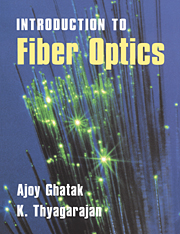Book contents
- Frontmatter
- Contents
- Preface
- Acknowledgments
- Abbreviations
- 1 Introduction: The fiber optics revolution
- 2 Basic optics
- 3 Basic characteristics of the optical fiber
- 4 Ray paths and pulse dispersion in planar optical waveguides
- 5 Pulse dispersion in graded index optical fibers
- 6 Material dispersion
- 7 Modes in planar waveguides
- 8 Propagation characteristics of a step index fiber
- 9 Propagation characteristics of graded index fibers
- 10 Waveguide dispersion and design considerations
- 11 Sources for optical fiber communication
- 12 Detectors for optical fiber communication
- 13 Design considerations of a fiber optic communication system
- 14 Optical fiber amplifiers
- 15 Dispersion compensation and chirping phenomenon
- 16 Optical solitons
- 17 Single-mode fiber optic components
- 18 Single-mode optical fiber sensors
- 19 Measurement methods in optical fibers: I
- 20 Measurement methods in optical fibers: II
- 21 Periodic interactions in waveguides
- 22 The ray equation in cartesian coordinates and its solutions
- 23 Ray paths and their classification in optical fibers
- 24 Leaky modes
- Appendix A Solution of the scalar wave equation for an infinite square law medium
- Appendix B The far-field pattern
- Appendix C WKB analysis of multimode fibers
- Appendix D Gaussian envelope approximation
- Appendix E Coupled-mode equations
- Appendix F Derivation of coupled-mode equation for periodic coupling
- Appendix G Leakage loss in optical waveguides
- References
- Index
24 - Leaky modes
Published online by Cambridge University Press: 05 June 2012
- Frontmatter
- Contents
- Preface
- Acknowledgments
- Abbreviations
- 1 Introduction: The fiber optics revolution
- 2 Basic optics
- 3 Basic characteristics of the optical fiber
- 4 Ray paths and pulse dispersion in planar optical waveguides
- 5 Pulse dispersion in graded index optical fibers
- 6 Material dispersion
- 7 Modes in planar waveguides
- 8 Propagation characteristics of a step index fiber
- 9 Propagation characteristics of graded index fibers
- 10 Waveguide dispersion and design considerations
- 11 Sources for optical fiber communication
- 12 Detectors for optical fiber communication
- 13 Design considerations of a fiber optic communication system
- 14 Optical fiber amplifiers
- 15 Dispersion compensation and chirping phenomenon
- 16 Optical solitons
- 17 Single-mode fiber optic components
- 18 Single-mode optical fiber sensors
- 19 Measurement methods in optical fibers: I
- 20 Measurement methods in optical fibers: II
- 21 Periodic interactions in waveguides
- 22 The ray equation in cartesian coordinates and its solutions
- 23 Ray paths and their classification in optical fibers
- 24 Leaky modes
- Appendix A Solution of the scalar wave equation for an infinite square law medium
- Appendix B The far-field pattern
- Appendix C WKB analysis of multimode fibers
- Appendix D Gaussian envelope approximation
- Appendix E Coupled-mode equations
- Appendix F Derivation of coupled-mode equation for periodic coupling
- Appendix G Leakage loss in optical waveguides
- References
- Index
Summary
Introduction
In any optical waveguide such as a planar waveguide or an optical fiber, guidance of light takes place through the phenomenon of total internal reflection. For this to happen, the guiding region has to have a refractive index larger than the surrounding regions. In a class of waveguides called leaky waveguides, the low index surrounding region has a finite thickness comparable to the penetration depth of the guided field, and beyond this distance the medium has an index equal to or greater than that of the guiding region. In such a case, the waves do not undergo total internal reflection and, thus, the reflection coefficient is less than unity. Such a phenomenon is known as frustrated total internal reflection (FTIR). Hence, in such waveguides, there are no perfectly guided modes. On the other hand, such waveguides have leaky modes that are characterized by a finite loss coefficient. Such leaky modes find applications in the realization of many devices such as in-line fiber polarizers (see Section 17.5.1). We also see in Section 24.5 that a bent waveguide is a leaky waveguide, and the loss due to bending can be understood as due to a leakage mechanism.
In Section 24.2 we discuss the leakage loss calculations using the ray picture, and in Section 24.3 we discuss the concept of quasimodes. In Section 24.4 we discuss the matrix method to numerically obtain leakage loss. Finally, in Section 24.5 we discuss the bending loss in optical waveguides.
- Type
- Chapter
- Information
- An Introduction to Fiber Optics , pp. 507 - 528Publisher: Cambridge University PressPrint publication year: 1998

